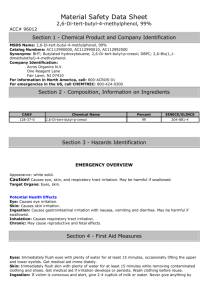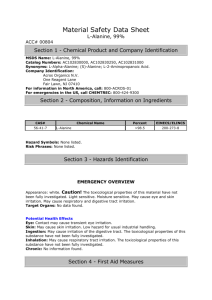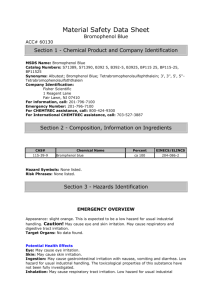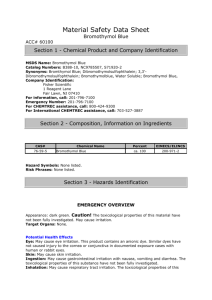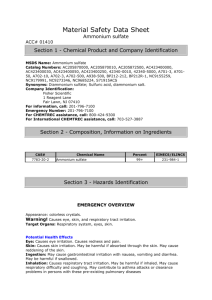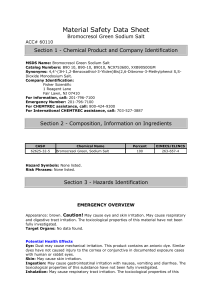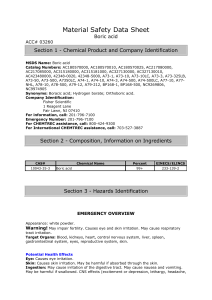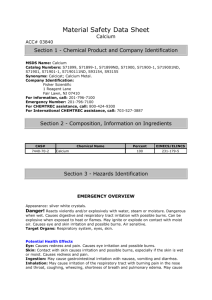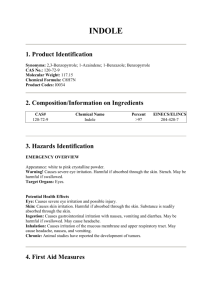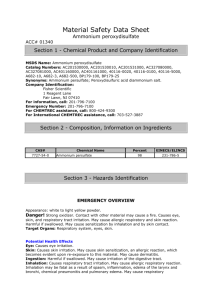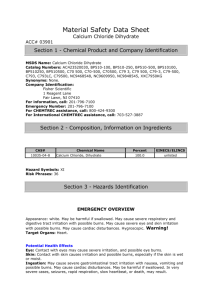Caffeine MSDS: Safety Data Sheet
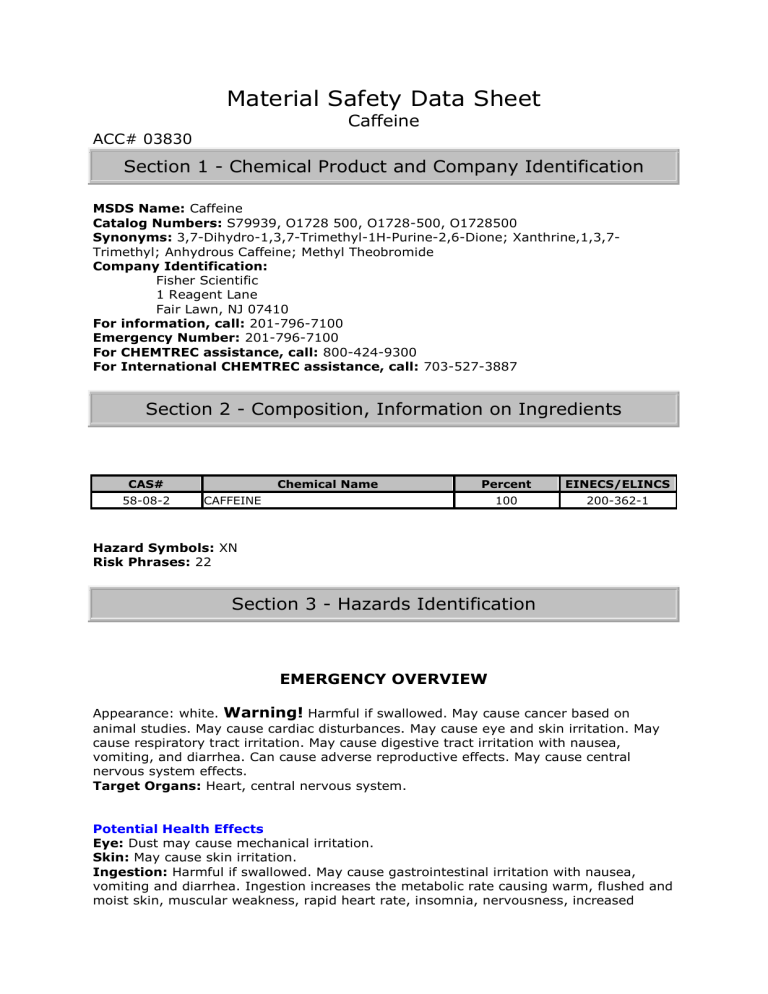
Material Safety Data Sheet
Caffeine
ACC# 03830
Section 1 - Chemical Product and Company Identification
MSDS Name: Caffeine
Catalog Numbers: S79939, O1728 500, O1728-500, O1728500
Synonyms: 3,7-Dihydro-1,3,7-Trimethyl-1H-Purine-2,6-Dione; Xanthrine,1,3,7-
Trimethyl; Anhydrous Caffeine; Methyl Theobromide
Company Identification:
Fisher Scientific
1 Reagent Lane
Fair Lawn, NJ 07410
For information, call: 201-796-7100
Emergency Number: 201-796-7100
For CHEMTREC assistance, call: 800-424-9300
For International CHEMTREC assistance, call: 703-527-3887
Section 2 - Composition, Information on Ingredients
CAS#
58-08-2 CAFFEINE
Chemical Name
Hazard Symbols: XN
Risk Phrases: 22
Percent
100
EINECS/ELINCS
200-362-1
Section 3 - Hazards Identification
EMERGENCY OVERVIEW
Appearance: white.
Warning!
Harmful if swallowed. May cause cancer based on animal studies. May cause cardiac disturbances. May cause eye and skin irritation. May cause respiratory tract irritation. May cause digestive tract irritation with nausea, vomiting, and diarrhea. Can cause adverse reproductive effects. May cause central nervous system effects.
Target Organs: Heart, central nervous system.
Potential Health Effects
Eye: Dust may cause mechanical irritation.
Skin: May cause skin irritation.
Ingestion: Harmful if swallowed. May cause gastrointestinal irritation with nausea, vomiting and diarrhea. Ingestion increases the metabolic rate causing warm, flushed and moist skin, muscular weakness, rapid heart rate, insomnia, nervousness, increased
metabolism and weight loss. May cause ataxia, blood pressure elevation, convulsions, hallucinations, hypermotility, muscle contraction or spasticity, somnolence (general depressed activity), toxic psychosis, and tremors.
Inhalation: May cause respiratory tract irritation. May cause effects similar to those described for ingestion.
Chronic: May cause cancer according to animal studies. May cause digestive tract and cardiac disturbances. May cause reproductive and fetal effects.
Section 4 - First Aid Measures
Eyes: Flush eyes with plenty of water for at least 15 minutes, occasionally lifting the upper and lower eyelids. Get medical aid.
Skin: Flush skin with plenty of soap and water for at least 15 minutes while removing contaminated clothing and shoes. Get medical aid if irritation develops or persists. Wash clothing before reuse.
Ingestion: Induce vomiting. If victim is conscious and alert, give 2-4 cupfuls of milk or water. Never give anything by mouth to an unconscious person. Get medical aid immediately.
Inhalation: Remove from exposure to fresh air immediately. If not breathing, give artificial respiration. If breathing is difficult, give oxygen. Get medical aid.
Notes to Physician: Treat symptomatically and supportively.
Section 5 - Fire Fighting Measures
General Information: As in any fire, wear a self-contained breathing apparatus in pressure-demand, MSHA/NIOSH (approved or equivalent), and full protective gear.
During a fire, irritating and highly toxic gases may be generated by thermal decomposition or combustion.
Extinguishing Media: In case of fire, use water, dry chemical, chemical foam, or alcohol-resistant foam. Use agent most appropriate to extinguish fire.
Section 6 - Accidental Release Measures
General Information: Use proper personal protective equipment as indicated in Section
8.
Spills/Leaks: Clean up spills immediately, observing precautions in the Protective
Equipment section. Sweep up, then place into a suitable container for disposal. Avoid generating dusty conditions. Provide ventilation.
Section 7 - Handling and Storage
Handling: Wash hands before eating. Use with adequate ventilation. Minimize dust generation and accumulation. Avoid contact with skin and eyes. Do not ingest or inhale.
Wash clothing before reuse.
Storage: Store in a tightly closed container. Store in a cool, dry, well-ventilated area away from incompatible substances.
Section 8 - Exposure Controls, Personal Protection
Engineering Controls: Use process enclosure, local exhaust ventilation, or other engineering controls to control airborne levels below recommended exposure limits.
Exposure Limits
Chemical Name
CAFFEINE
ACGIH none listed
NIOSH none listed
OSHA - Final PELs none listed
OSHA Vacated PELs: CAFFEINE: No OSHA Vacated PELs are listed for this chemical.
Personal Protective Equipment
Eyes: Wear appropriate protective eyeglasses or chemical safety goggles as described by OSHA's eye and face protection regulations in 29 CFR 1910.133 or European
Standard EN166.
Skin: Wear appropriate protective gloves to prevent skin exposure.
Clothing: Wear appropriate protective clothing to minimize contact with skin.
Respirators: Follow the OSHA respirator regulations found in 29CFR 1910.134 or
European Standard EN 149. Always use a NIOSH or European Standard EN 149 approved respirator when necessary.
Section 9 - Physical and Chemical Properties
Physical State: Solid
Appearance: white
Odor: odorless
pH: Not available.
Vapor Pressure: Negligible.
Vapor Density: Not available.
Evaporation Rate:Negligible.
Viscosity: Not available.
Boiling Point: 352 deg F
Freezing/Melting Point:460 deg F
Autoignition Temperature: Not applicable.
Flash Point: Not applicable.
Decomposition Temperature:Not available.
NFPA Rating: (estimated) Health: 2; Flammability: 0; Reactivity: 0
Explosion Limits, Lower:Not available.
Upper: Not available.
Solubility: Slightly soluble in water.
Specific Gravity/Density:1.23
Molecular Formula:C8H10N4O2
Molecular Weight:194.0956
Section 10 - Stability and Reactivity
Chemical Stability: Stable at room temperature in closed containers under normal storage and handling conditions.
Conditions to Avoid: Incompatible materials, dust generation, excess heat.
Incompatibilities with Other Materials: Strong oxidizing agents.
Hazardous Decomposition Products: Nitrogen oxides, carbon monoxide, irritating and toxic fumes and gases, carbon dioxide.
Hazardous Polymerization: Has not been reported.
Section 11 - Toxicological Information
RTECS#:
CAS# 58-08-2: EV6475000
LD50/LC50:
CAS# 58-08-2:
Oral, mouse: LD50 = 127 mg/kg;
Oral, rabbit: LD50 = 224 mg/kg;
Oral, rat: LD50 = 192 mg/kg;<BR.
Carcinogenicity:
CAS# 58-08-2:
IARC: Group 3 carcinogen
Epidemiology: Experimental reproductive effects have been reported.
Teratogenicity: A human teratogen, causes developmental abnormalities of the craniofacial and musculoskeletal systems, pregnancy termination and stillbirth.
Reproductive Effects: See above.
Neurotoxicity: No information available.
Mutagenicity: No information available.
Other Studies: See actual entry in RTECS for complete information.
Section 12 - Ecological Information
Ecotoxicity: No data available. No information available.
Environmental: TERRESTRIAL FATE: If released to soil, estimated soil adsorption indicate that caffeine will display very high mobility. An estimated Henry's Law constant of 1.9X10-19 atm-cu m/mole at 25 deg C indicates that it will not volatilize from moist soil to the atmosphere. AQUATIC FATE: If released to water caffiene will not bioconcentrate aquatic organisms. ATMOSPHERIC FATE: Exists predominantly in the particulate phase, half life 2.5 hours. Expected to biodegrade but not bioconcentrate.
Physical: No information available.
Other: No information available.
Section 13 - Disposal Considerations
Chemical waste generators must determine whether a discarded chemical is classified as a hazardous waste. US EPA guidelines for the classification determination are listed in 40
CFR Parts 261.3. Additionally, waste generators must consult state and local hazardous waste regulations to ensure complete and accurate classification.
RCRA P-Series: None listed.
RCRA U-Series: None listed.
Section 14 - Transport Information
US DOT
Shipping Name:
ALKALOIDS,
SOLID,
N.O.S.
(CAFFEINE)
Hazard Class: 6.1
UN Number: UN1544
Packing Group: III
IATA RID/ADR IMO
Section 15 - Regulatory Information
US FEDERAL
TSCA
CAS# 58-08-2 is listed on the TSCA inventory.
Health & Safety Reporting List
None of the chemicals are on the Health & Safety Reporting List.
Chemical Test Rules
None of the chemicals in this product are under a Chemical Test Rule.
Section 12b
None of the chemicals are listed under TSCA Section 12b.
TSCA Significant New Use Rule
None of the chemicals in this material have a SNUR under TSCA.
SARA
Section 302 (RQ)
None of the chemicals in this material have an RQ.
Section 302 (TPQ)
None of the chemicals in this product have a TPQ.
SARA Codes
CAS # 58-08-2: acute.
Section 313
Canada
TDG
ALKALOIDS,
SOLID,NOS
(CAFFEINE)
6.1
UN1544
III
No chemicals are reportable under Section 313.
Clean Air Act:
This material does not contain any hazardous air pollutants. This material does not contain any Class 1 Ozone depletors. This material does not contain any Class 2 Ozone depletors.
Clean Water Act:
None of the chemicals in this product are listed as Hazardous Substances under the
CWA. None of the chemicals in this product are listed as Priority Pollutants under the
CWA. None of the chemicals in this product are listed as Toxic Pollutants under the CWA.
OSHA:
None of the chemicals in this product are considered highly hazardous by OSHA.
STATE
CAS# 58-08-2 is not present on state lists from CA, PA, MN, MA, FL, or NJ.
California No Significant Risk Level: None of the chemicals in this product are listed.
European/International Regulations
European Labeling in Accordance with EC Directives
Hazard Symbols:
XN
Risk Phrases:
R 22 Harmful if swallowed.
Safety Phrases:
WGK (Water Danger/Protection)
CAS# 58-08-2: 1
Canada
CAS# 58-08-2 is listed on Canada's DSL List. CAS# 58-08-2 is listed on Canada's DSL
List.
This product has a WHMIS classification of D1B, D2B.
CAS# 58-08-2 is not listed on Canada's Ingredient Disclosure List.
Exposure Limits
CAS# 58-08-2: OEL-RUSSIA:STEL 0.5 mg/m3
Section 16 - Additional Information
MSDS Creation Date: 2/16/1999
Revision #1 Date: 8/02/2000
The information above is believed to be accurate and represents the best information currently available to us.
However, we make no warranty of merchantability or any other warranty, express or implied, with respect to such information, and we assume no liability resulting from its use. Users should make their own investigations to determine the suitability of the information for their particular purposes. In no event shall Fisher be liable for any claims, losses, or damages of any third party or for lost profits or any special, indirect, incidental, consequential or exemplary damages, howsoever arising, even if Fisher has been advised of the possibility of such damages.
